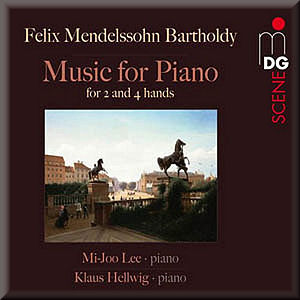 |
 |
| 

alternatively
CD: MDT
AmazonUK
AmazonUS
|
Felix MENDELSSOHN
(1809-1847)
Sechs Präludien und Fugen op. 35 (1831-37) [40:19]
Ouvertüre zum Sommernachtstraum
(arr. for Piano for 4 Hands by Felix Mendelssohn Bartholdy) (1826,
arr. 1832) [11:28]
Andante con Variazioni op. 83a (1841) (version for 4 Hands, 1844)
[11:38]
Andante und Allegro assai vivace op. 92 (1841) [10:50]
 Mi-Joo Lee (piano); Klaus Hellwig (piano, Ouvertüre, Andante
opp.83a, 92)
Mi-Joo Lee (piano); Klaus Hellwig (piano, Ouvertüre, Andante
opp.83a, 92)
rec. 25-27 January 2010, Ackerhaus der Abtei Marienmünster
 MUSIKPRODUKTION DABRINGHAUS UND GRIMM
MUSIKPRODUKTION DABRINGHAUS UND GRIMM  MDG
904 1653-6 [74:45] MDG
904 1653-6 [74:45] 
|
|
|
Felix Mendelssohn is recognised for helping revive the reputation
of J.S. Bach, but it was his mother who encouraged Felix and
his sister Fanny to play Bach. This early keyboard exploration
of Bach’s forms and counterpoint is no doubt responsible for
the many fugues and preludes in Mendelssohn’s output, and the
Sechs Präludien und Fugen op. 35 are prime examples.
The shapes of the fugue themes in particular echo Bach’s model,
and it is impossible to hear the opening of the A flat major
fugue, for instance, without thinking of the Well Tempered Clavier.
Mendelssohn’s song-like flow and love of chorales are all part
of the mix, and the pieces are by no means a pale imitation
of Bach. Not conceived as a cycle, these preludes & fugues
nevertheless traverse a wide range of approaches and styles,
creating a nicely contrasting set. The adaptation of Mendelssohn’s
idiom into ‘antique’ styles of polyphony results in the kind
of intensification of ideas within a fugue which makes for a
variation-form feel and grand climaxes. Mendelssohn’s skill
however maintains a sincere clarity, and even where all the
stops are pulled out one can sense a lack of pomposity and bombast
– ably assisted of course by the fine playing of Mi-Joo Lee.
Schumann was famously inspired to state that Mendelssohn’s Preludes
& Fugues were “birches, where Bach once placed such mighty
oaks...” and “compositions born of the spirit and executed in
poetic style.”
The playing of piano duets was a strong element of music making
in households at this time, and the Mendelssohn residence was
no exception. Arrangements of the latest symphonic or operatic
hits would inevitably have arrangements made, and be made widely
popular through domestic use. The problem with Mendelssohn and
his sister Fanny is that they had far too much skill and fun,
and would play through all kinds of repertoire without needing
to go through all the tedious effort of writing down the notes.
As a result there is very little of Mendelssohn’s own work in
this genre which reaches us. The Ouvertüre zum Sommernachtstraum
was eventually arranged for piano duet in a simplified but
still highly virtuosic form - the one developed by Felix and
Fanny over numerous performances done from the score must have
been remarkable indeed. This is always a refreshingly inspired
piece, and comes across with plenty of colour and sparkle from
the duet on this recording.
The Andante con Variazioni op. 83a is an arrangement
and expansion of the original Op.83 version for two hands, made
in haste by Mendelssohn for one of Fanny’s ‘Sonntagsmusiken’
concerts. The original five variations received an additional
three movements, and the whole given plenty of extra technical
fireworks. The Andante und Allegro assai vivace op. 92 was
especially written for and appeared on the 1841 Leipzig Gewandhaus
programme played by Felix Mendelssohn and Clara Schumann, the
same concert at which Schumann’s first symphony was premiered.
There is a certain amount of editorial interest with this piece,
with the first published engraving being derived from an incomplete
draft and not the final copy, which was first published only
in 1994. The best known element is the Allegro, which
is here preceded with the more recently added Andante introduction.
Of all the pieces here this is the most remarkable in terms
of its musical content – the virtuoso elements taking hold of
the textural content of the work in ways which can take you
quite by surprise, almost approaching the kinds of thing I’ve
become more used to hearing in MDG’s ‘Player Piano’ series.
Mi-Joo Lee has received justified plaudits for her previous
recordings of Schumann and Saint-Saëns on the MDG label, and
fans will have plenty to entertain them with this Mendelssohn
disc. The duet pieces with Klaus Hellwig are technically flawless
and very sensitively performed in true chamber music style,
and there are few enough recordings of this repertoire around
to make this a very welcome top-flight addition to the catalogue.
There is a bit of lower mid-range bloom in the piano sound,
but any mild sponginess snaps more into focus with SACD decoding.
I have no doubt MDG’s 2+2+2 setup would bring even more improvements,
but in essence the sound is very good all round, with plenty
of depth and colour.
Dominy Clements
|
|

